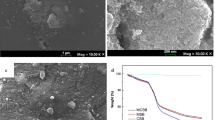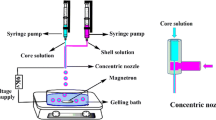Abstract
Sodium alginate (SA) is a linear biopolymer, which is the nontoxic, biodegradable, and rich in carboxyl and hydroxyl groups. In the paper, the SA-based hydrogel bead was prepared by the cationic hectorite clay and anionic sodium alginate with a simple ionic gelation method under freeze-drying, and the adsorption properties were evaluated by the removal of copper ions from aqueous solutions. The composites were characterized by X-ray diffraction (XRD), nitrogen adsorption-desorption isotherm (BET), thermal analysis (TG), and Fourier transform infrared spectroscopy (FT-IR). The pseudo-first-order and pseudo-second-order kinetic models were used to describe the kinetic data and the Langmuir, Freundlich, Dubinin–Radushkevich (D-R), and Temkin models were applied to describe the adsorption isotherms. The results showed that the adsorption process was found to follow the Freundlich isotherm model and the maximum sorption capacity was observed to be 160.28 mg/g under the initial concentration from 10 to 700 mg/L at 45 °C. Adsorption kinetics data fitted well with pseudo-second-order rate model. The porous structure of the composite was responsible for the adsorption of Cu2+ ions. But the adsorption ability could be improved by pH. Finally, the adsorption mechanism was suggested.

Graphical abstract









Similar content being viewed by others
References
Acero JL, Benitez FJ, Real FJ, Teva F (2016) Micropollutants removal from retentates generated in ultrafiltration and nanofiltration treatments of municipal secondary effluents by means of coagulation, oxidation, and adsorption processes. Chem Eng J 289:48–58
Barati A, Asgari M, Miri T, Eskandari Z (2013) Removal and recovery of copper and nickel ions from aqueous solution by poly(methacrylamide-co-acrylic acid)/montmorillonite nanocomposites. Environ Sci Pollut Res 20:6242–6255
Barreca S, Orecchio S, Pace A (2014) The effect of montmorillonite clay in alginate gel beads for polychlorinated biphenyl adsorption: isothermal and kinetic studies. Appl Clay Sci 99:220–228
Bouhamed F, Elouear Z, Bouzid J, Ouddane B (2016) Multi-component adsorption of copper, nickel and zinc from aqueous solutions onto activated carbon prepared from date stones. Environ Sci Pollut Res 23:15801–15806
Cho DW, Jeon BH, Chon CM, Kim Y, Schwartz FW, Lee ES, Song H (2012) A novel chitosan/clay/magnetite composite for adsorption of Cu(II) and As(V). Chem Eng J 200-202:654–662
Delavernhe L, Pilavtepe M, Emmerich K (2018) Cation exchange capacity of natural and synthetic hectorite. Appl Clay Sci 151:175–180
Fan NQ, Fan YX, Tong DS, Zhou CH, Ge ZH (2010) Study on structure characteristics of organic hectorite hydrothermally synthesized in reaction medium with the presence of surfactants. J Chem Eng Chin Univ 24:852–857
Fu W, Huang ZQ (2018) Magnetic dithiocarbamate functionalized reduced graphene oxide for the removal of Cu(II), Cd(II), Pb(II), and Hg(II) ions from aqueous solution: synthesis, adsorption, and regeneration. Chemosphere 209:449–456
Ghasemi M, Keshtkar AR, Dabbagh R, Safdari SJ (2011) Biosorption of uranium(VI) from aqueous solutions by Ca-pretreated Cystoseira indica alga: breakthrough curves studies and modeling. J Hazard Mater 189:141–149
Guemiza K, Coudert L, Metahni S, Mercier G, Besner S, Blais JF (2017) Treatment technologies used for the removal of As, Cr, Cu, PCP and/or PCDD/F from contaminated soil: a review. J Hazard Mater 333:194–214
Guo YX, Jia ZQ (2018) Sandwiched Zr (IV)-based coordinate porous materials membranes for adsorption of copper(II) from water. Mater Lett 228:239–241
Guo XY, Zhang SZ, Shan XQ (2008) Adsorption of metal ions on lignin. J Hazard Mater 151:134–142
Hu C, Zhu PF, Cai M, Hu HQ, Fu QL (2017) Comparative adsorption of Pb(II), Cu(II) and Cd(II) on chitosan saturated montmorillonite: kinetic, thermodynamic and equilibrium studies. Appl Clay Sci 143:320–326
Jalali MA, Koohi AD, Sheykhan M (2016) Experimental study of the removal of copper ions using hydrogels of xanthan, 2-acrylamido-2-methyl-1-propane sulfonic acid, montmorillonite: kinetic and equilibrium study. Carbohydr Polym 142:124–132
Jaycock MJ, Parfitt GD (1981) Chemistry of interfaces
Kamaraj R, Pandiarajan A, Jayakiruba S, Naushad M, Vasudevan S (2016) Kinetics, thermodynamics and isotherm modeling for removal of nitrate from liquids by facile one-pot electrosynthesized nano zinc hydroxide. J Mol Liq 215:204–211
Karthik R, Meenakshi S (2015) Removal of Cr(VI) ions by adsorption onto sodium alginate-polyaniline nanofibers. Int J Biol Macromol 72:711–717
Kousalya GN, Gandhi MR, Viswanathan N, Meenakshi S (2010) Preparation and metal uptake studies of modified forms of chitin. Int J Biol Macromol 47:583–589
Li J, Zuo KM, Wu WB, Xu ZY, Yi YG, Jing Y, Dai HQ, Fangc GG (2018) Shape memory aerogels from nanocellulose and polyethyleneimine as a novel adsorbent for removal of Cu(II) and Pb(II). Carbohydr Polym 196:376–384
Luo C, Wei RY, Guo D, Zhang SF, Yan SQ (2013) Adsorption behavior of MnO2 functionalized multi-walled carbon nanotubes for the removal of cadmium from aqueous solutions. Chem Eng J 225:406–415
Ma J, Jia YZ, Jing Y, Yao Y, Sun JH (2012) Kinetics and thermodynamics of methylene blue adsorption by cobalt-hectorite composite. Dyes Pigments 93:1441–1446
Madejova J, Komadel P (2001) Baseline studies of the clay minerals society source clays: infrared methods. Clay Clay Miner 49:410–432
Mejia GV, Martinez-Miranda V, Fall C, Linares-Hernandez I, Solache-Rios M (2016) Comparison of Fe-Al-modified natural materials by an electrochemical method and chemical precipitation for the adsorption of F- and As(V). Environ Technol 37:558–568
Mittal H, Parashar V, Mishra SB, Mishra AK (2014) Fe3O4 MNPs and gum xanthan based hydrogels nanocomposites for the efficient capture of malachite green from aqueous solution. Chem Eng J 255:471–482
Ngah WSW, Fatinathan S (2008) Adsorption of Cu(II) ions in aqueous solution using chitosan beads, chitosan-GLA beads and chitosan-alginate beads. Chem Eng J 143:62–72
Oh JM, Biswick TT, Choy JH (2009) Layered nanomaterials for green materials. J Mater Chem 19:2553–2563
Pandey S, Mishra SB (2012) Microwave synthesized xanthan gum-g-poly(ethylacrylate): an efficient Pb2+ ion binder. Carbohydr Polym 90:370–379
Pawar RR, Patel HA, Sethia G, Bajaj HC (2009) Selective adsorption of carbon dioxide over nitrogen on calcined synthetic hectorites with tailor-made porosity. Appl Clay Sci 46:109–113
Rengaraj S, Yeon JW, Kim Y, Jung Y, Ha YK, Kim WH (2007) Adsorption characteristics of Cu(II) onto ion exchange resins 252H and 1500H: kinetics, isotherms and error analysis. J Hazard Mater 143:469–477
Sahu UK, Sahu S, Mahapatra SS, Patel RK (2017) Cigarette soot activated carbon modified with Fe3O4 nanoparticles as an effective adsorbent for As(III) and As(V): material preparation, characterization and adsorption mechanism study. J Mol Liq 243:395–405
Shahraki S, Delarami HS (2018) Magnetic chitosan-(D-glucosimine methyl)benzaldehyde Schiff base for Pb+2 ion removal. Experimental and theoretical methods. Carbohydr Polym 200:211–220
Sun L, Fugetsu B (2014) Graphene oxide captured for green use: influence on the structures of calcium alginate and macroporous alginic beads and their application to aqueous removal of acridine orange. Chem Eng J 240:565–573
Tsai WC, Ibarra-Buscano S, Kan CC, Futalan CM, Dalida MLP, Wan MW (2016) Removal of copper, nickel, lead, and zinc using chitosan-coated montmorillonite beads in single- and multi-metal system. Desalin Water Treat 57:9799–9812
Vicente I, Salagre P, Cesteros Y, Guirado F, Medina F, Sueiras JE (2009) Fast microwave synthesis of hectorite. Appl Clay Sci 43:103–107
Wang YZ, Wang WB, Shi XN, Wang AQ (2013a) A superabsorbent nanocomposite based on sodium alginate and illite/smectite mixed-layer clay. J Appl Polym Sci 130:161–167
Wang YZ, Wang WB, Wang AQ (2013b) Efficient adsorption of methylene blue on an alginate-based nanocomposite hydrogel enhanced by organo-illite/smectite clay. Chem Eng J 228:132–139
Xu J, Cao Z, Zhang YL, Yuan ZL, Lou ZM, Xu XH, Wang XK (2018) A review of functionalized carbon nanotubes and graphene for heavy metal adsorption from water: preparation, application, and mechanism. Chemosphere 195:351–364
Yi XF, He JR, Guo YY, Han ZH, Yang MX, Jin JL, Gu JJ, Ou MR, Xu XP (2018) Encapsulating Fe3O4 into calcium alginate coated chitosan hydrochloride hydrogel beads for removal of Cu (II) and U (VI) from aqueous solutions. Ecotoxicol Environ Saf 147:699–707
Youssef AM, Ahmed AI, Amin MI, El-Banna UA (2015) Adsorption of lead by activated carbon developed from rice husk. Desalin Water Treat 54:1694–1707
Zhang D, Zhou CH, Lin CX, Tong DS, Yu WH (2010) Synthesis of clay minerals. Appl Clay Sci 50:1–11
Zhang YJ, Ou JL, Duan ZK, Xing ZJ, Wang Y (2015) Adsorption of Cr(VI) on bamboo bark-based activated carbon in the absence and presence of humic acid. Colloid Surf A Physicochem Eng Asp 481:108–116
Zhang W, Deng Q, He QL, Song JY, Zhang SL, Wang HY, Zhou JP, Zhang HN (2018a) A facile synthesis of core-shell/bead-like poly (vinyl alcohol)/alginate@PAM with good adsorption capacity, high adaptability and stability towards Cu(II) removal. Chem Eng J 351:462–472
Zhang YZ, Lin SC, Qiao JQ, Kolodynska D, Ju YM, Zhang MW, Cai MF, Deng DY, Dionysiou DD (2018b) Malic acid-enhanced chitosan hydrogel beads (mCHBs) for the removal of Cr(VI) and Cu(II) from aqueous solution. Chem Eng J 353:225–236
Zhou CH, Zhang D, Tong DS, Wu LM, Yu WH, Ismadji S (2012) Paper-like composites of cellulose acetate-organo-montmorillonite for removal of hazardous anionic dye in water. Chem Eng J 209:223–234
Acknowledgements
The authors wish to acknowledge the National Natural Scientific Foundation of China (21506188), the Natural Scientific Foundation of Zhejiang Province ZJNSF (LY16B030010), China Postdoctoral Science Foundation (2018 M630688), the project from Science and Technology Department of Wenzhou (G20180017), and Project of Zhejiang″151″ talents project.
Author information
Authors and Affiliations
Corresponding author
Additional information
Responsible editor: Ioannis A. Katsoyiannis
Publisher’s note
Springer Nature remains neutral with regard to jurisdictional claims in published maps and institutional affiliations.
Rights and permissions
About this article
Cite this article
Tong, D., Fang, K., Yang, H. et al. Efficient removal of copper ions using a hydrogel bead triggered by the cationic hectorite clay and anionic sodium alginate. Environ Sci Pollut Res 26, 16482–16492 (2019). https://doi.org/10.1007/s11356-019-04895-8
Received:
Accepted:
Published:
Issue Date:
DOI: https://doi.org/10.1007/s11356-019-04895-8




